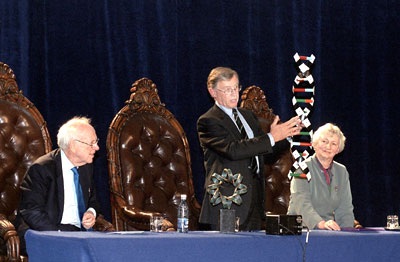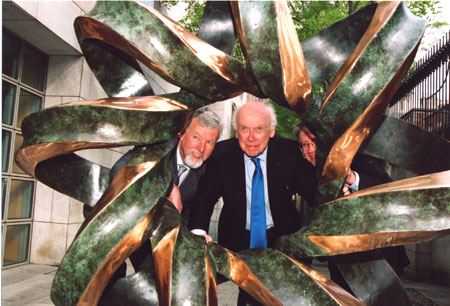| 2003 |

|
YEAR BOOK |
Trinity College Dublin
|
A celebration of the DNA double helix at 50
|
To celebrate the fiftieth anniversary of this momentous discovery, a series of events were held in Trinity College Dublin, hosted by the staff and students of the Smurfit Institute of Genetics. These events included a series of public lectures on various topics in genetics, presented in association with The Irish Times, and culminated with a visit to the College by one of the co-discoverers of the double helix, Dr James Watson, Nobel Laureate. Dr Watson's visit was generously sponsored by and organised in association with Science Foundation Ireland.

The lecture was Webcast live around the world, with associated events at many universities around the country. The Webcast was sponsored by a generous grant from BioResearch Ireland, and broadcast via HEAnet. The Webcast stream can be viewed (on a PC) at: http://www.heanet.ie/projects/videoservices/videostreaming/watson%20stream/
Dr Watson gave both a personal history of the work leading up to the groundbreaking discovery and a description of its influence on the development of the field of molecular genetics. At the time that he and Crick, along with a number of other researchers including Maurice Wilkins and Rosalind Franklin, were working to discover the structure of DNA, the following facts were known: Genes had been defined as 'units of heredity' that specified various traits of an organism, passing from one generation to the next and coming together in different combinations. Genes were located on chromosomes, which were made of two types of molecule: proteins and deoxyribonucleic acid, or DNA. The 'genetic material' itself had been shown in 1944 to be composed of DNA; this theory, however, was not widely accepted. DNA seemed far too simple a molecule to fulfil this role, composed of only four types of subunit, A, C, G and T, in roughly equal amounts, with apparently very little potential to store information that could be replicated. It was utterly mysterious how this molecule could be the medium of heredity.

Dr Watson also presented his views on how the diverse issues arising from potential applications of genetic research should be dealt with by society, with 'common sense' as the guiding principle. In a note that was echoed by the speakers who followed, he emphasised the crucial importance that scientific education will have in enabling individuals and society to make informed choices about the increasing number of genetic issues with which we will all be faced. Dr O'Neill gave a thoughtful response from a philosophical and ethical perspective, sounding a cautionary but optimistic note. Professor McConnell closed the session with a consideration of the impact that the discovery of the DNA double helix has had on genetic research, and an explanation of why it deserves its iconic status as, truly, 'the secret of life'.
This is an edited version of an article which appeared in the 2003-4 edition of the alumni magazine, Trinity Today.
Contact: Dr Kevin Mitchell, Lecturer and SFI Investigator, Department of Genetics, Trinity College, Dublin 2; Tel: +353-1-608-3067; Fax: +353-1-679-8558